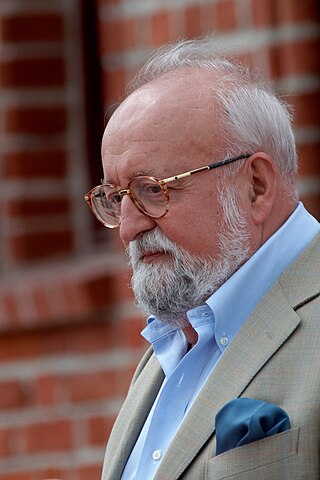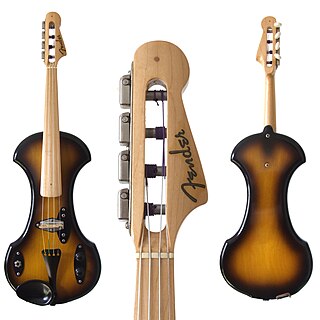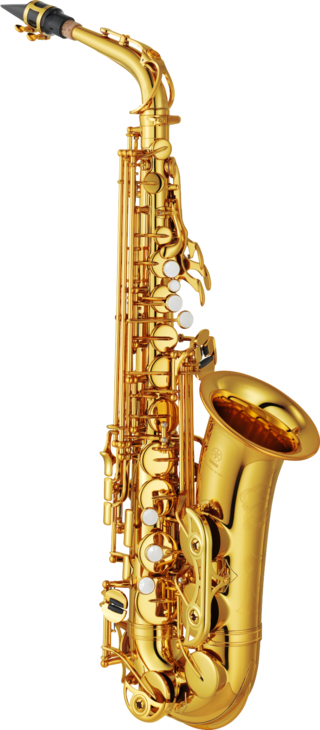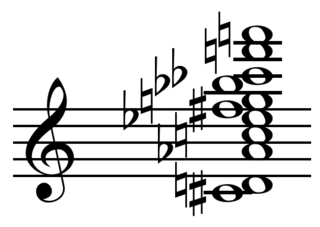
The cello ( CHEL-oh), or violoncello ( VY-ə-lən-CHEL-oh, Italian pronunciation:[vjolonˈtʃɛllo]), is a bowed (sometimes plucked and occasionally hit) string instrument of the violin family. Its four strings are usually tuned in perfect fifths: from low to high, C2, G2, D3 and A3. The viola's four strings are each an octave higher. Music for the cello is generally written in the bass clef, with tenor clef, and treble clef used for higher-range passages.

Krzysztof Eugeniusz Penderecki was a Polish composer and conductor. His best-known works include Threnody to the Victims of Hiroshima, Symphony No. 3, his St Luke Passion, Polish Requiem, Anaklasis and Utrenja. His oeuvre includes four operas, eight symphonies and other orchestral pieces, a variety of instrumental concertos, choral settings of mainly religious texts, as well as chamber and instrumental works.

The glockenspiel or bells is a percussion instrument consisting of pitched aluminum or steel bars arranged in a keyboard layout. This makes the glockenspiel a type of metallophone, similar to the vibraphone.

Timpani or kettledrums are musical instruments in the percussion family. A type of drum categorised as a hemispherical drum, they consist of a membrane called a head stretched over a large bowl traditionally made of copper. Thus timpani are an example of kettle drums, also known as vessel drums and semispherical drums, whose body is similar to a section of a sphere whose cut conforms the head. Most modern timpani are pedal timpani and can be tuned quickly and accurately to specific pitches by skilled players through the use of a movable foot-pedal. They are played by striking the head with a specialized drum stick called a timpani stick or timpani mallet. Timpani evolved from military drums to become a staple of the classical orchestra by the last third of the 18th century. Today, they are used in many types of ensembles, including concert bands, marching bands, orchestras, and even in some rock bands.

Tōru Takemitsu was a Japanese composer and writer on aesthetics and music theory. Largely self-taught, Takemitsu was admired for the subtle manipulation of instrumental and orchestral timbre. He is known for combining elements of oriental and occidental philosophy and for fusing sound with silence and tradition with innovation.

An electric violin is a violin equipped with an electronic output of its sound. The term most properly refers to an instrument intentionally made to be electrified with built-in pickups, usually with a solid body. It can also refer to a violin fitted with an electric pickup of some type, although "amplified violin" or "electro-acoustic violin" are more accurate then.

The alto saxophone is a member of the saxophone family of woodwind instruments. Saxophones were invented by Belgian instrument designer Adolphe Sax in the 1840s and patented in 1846. The alto saxophone is pitched in the key of E♭, smaller than the B♭ tenor but larger than the B♭ soprano. It is the most common saxophone and is used in popular music, concert bands, chamber music, solo repertoire, military bands, marching bands, pep bands, and jazz.

Threnody to the Victims of Hiroshima, also translated as Threnody for the Victims of Hiroshima, is a musical composition for 52 string instruments composed in 1961 by Krzysztof Penderecki. Dedicated to the residents of Hiroshima killed and injured by the first-ever wartime usage of an atomic weapon, the composition won the Tribune Internationale des Compositeurs UNESCO prize that same year.

In musical composition, a sound mass(also sound collective, sound complex, tone shower, sound crowd, or cloud) is the result of compositional techniques, in which, "the importance of individual pitches", is minimized, "in preference for texture, timbre, and dynamics as primary shapers of gesture and impact", obscuring, "the boundary between sound and noise".
Sonorism is an approach to musical composition associated with a number of notable Polish composers. The scholar Józef Michał Chomiński coined the term "sonoristics" to describe the urge to explore purely sonic phenomena in composition, and from this term derived "sonorism" to describe an avant-garde style in Polish music of the 1960s that focused on timbre. As a movement, sonorism was initiated in the 1950s in the avant-garde of Polish music. Music that emphasises sonorism as a compositional approach tends to focus on specific characteristics and qualities of timbre, texture, articulation, dynamics, and motion in an attempt to create freer form. The style is primarily associated with an experimental musical movement which arose in Poland in the mid-1950s and flourished through the 1960s.

Die Teufel von Loudun is an opera in three acts written in 1968 and 1969 by Polish composer Krzysztof Penderecki, and then revised in 1972 and 1975. It has a German libretto by the composer, based on John Whiting's dramatization of Aldous Huxley's book of the same name.

The Art of Noises is a Futurist manifesto written by Luigi Russolo in a 1913 letter to friend and Futurist composer Francesco Balilla Pratella. In it, Russolo argues that the human ear has become accustomed to the speed, energy, and noise of the urban industrial soundscape; furthermore, this new sonic palette requires a new approach to musical instrumentation and composition. He proposes a number of conclusions about how electronics and other technology will allow futurist musicians to "substitute for the limited variety of timbres that the orchestra possesses today the infinite variety of timbres in noises, reproduced with appropriate mechanisms".
String instruments are capable of producing a variety of extended technique sounds. These alternative playing techniques have been used extensively since the 20th century. Particularly famous examples of string instrument extended technique can be found in the music of Krzysztof Penderecki, Witold Lutosławski, George Crumb, and Helmut Lachenmann.

The 3rd bridge is an extended playing technique used on the electric guitar and other string instruments that allows a musician to produce distinctive timbres and overtones that are unavailable on a conventional string instrument with two bridges. The timbre created with this technique is close to that of gamelan instruments like the bonang and similar Indonesian types of pitched gongs.
A third bridge can be devised by inserting a rigid preparation object between the strings and the body or neck of the instrument, effectively dividing the string into distinct vibrating segments.

The Symphony No. 3 is a symphony in five movements composed between 1988 and 1995 by Krzysztof Penderecki. It was commissioned and completed for the centenary of the Munich Philharmonic. Its earliest version, Passacaglia and Rondo, premiered at the International Music Festival Week in Lucerne, Switzerland, on August 20, 1988. It was performed by the Lucerne Festival Orchestra and conducted by Penderecki. The full symphony premiered in Munich on 8 December 1995, performed by the Munich Philharmonic, again conducted by the composer.

Anaklasis is a composition for 42 string instruments and percussion, composed in 1960 by the Polish composer Krzysztof Penderecki. It was first performed at the Donaueschingen Festival in 1960. At this first performance, it was well received by the audience who demanded an encore.
Utrenja, alternatively spelled as Utrenia, Utrenya, or Jutrznia, and sometimes also translated as Matins, is a set of two liturgical compositions by Polish composer Krzysztof Penderecki. They were composed and premiered in 1970 and 1971.
Fonogrammi, for flute and chamber orchestra, is a composition by Polish composer Krzysztof Penderecki. It was finished in 1961 and was published by Schott Music, even though it remained initially unpublished.

The Dream of Jacob, also referred to as The Awakening of Jacob, is a composition by Polish composer Krzysztof Penderecki. It is scored for large orchestra and was finished in 1974.

Penderecki's setting of the biblical canticle Magnificat was commissioned for the 1200th anniversary of Salzburg Cathedral and premiered there on 17 August 1974 under the composer's baton. It is a vast work, being scored for bass vocal soloist, boys’ voices, seven other men’s voices, two 24-part mixed choirs and orchestra.











